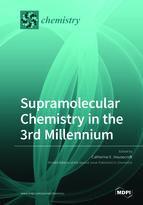Supramolecular Chemistry in the 3rd Millennium
A special issue of Chemistry (ISSN 2624-8549). This special issue belongs to the section "Supramolecular Chemistry".
Deadline for manuscript submissions: closed (31 May 2020) | Viewed by 63161
Special Issue Editor
Interests: light harvesting using inorganic coordination complexes as dyes in dye-sensitized solar cells (DSCs); development of emissive complexes for application in light-emitting electrochemical cells (LECs); water splitting and water oxidation catalysts; functional coordination polymers and networks; chemical education
Special Issues, Collections and Topics in MDPI journals
Special Issue Information
Dear Colleagues,
This Special Issue is one of the first for the new MDPI flagship journal Chemistry (ISSN 2624-8549) which has a broad remit for publishing original research in all areas of chemistry. The theme of this issue is Supramolecular Chemistry in the 3rd Millennium and I am sure that this topic will attract many exciting contributions. We chose this topic because it encompasses the unity of contemporary pluridisciplinary science, in which organic, inorganic, physical and theoretical chemists work together with molecular biologists and physicists to develop a systems-level understanding of molecular interactions. The description of supramolecular chemistry as ‘chemistry beyond the molecule’ (Jean-Marie Lehn, Nobel Lecture and Gautam R. Desiraju, Nature, 2001, 412, 397) addresses the wide variety of weak, non-covalent interactions that are the basis for the assembly of supramolecular architectures, molecular receptors and molecular recognition, programed molecular systems, dynamic combinatorial libraries, coordination networks and functional supramolecular materials. We welcome submissions from all disciplines involved in this exciting and evolving area of science.
Prof. Dr. Catherine Housecroft
Guest Editor
Manuscript Submission Information
Manuscripts should be submitted online at www.mdpi.com by registering and logging in to this website. Once you are registered, click here to go to the submission form. Manuscripts can be submitted until the deadline. All submissions that pass pre-check are peer-reviewed. Accepted papers will be published continuously in the journal (as soon as accepted) and will be listed together on the special issue website. Research articles, review articles as well as short communications are invited. For planned papers, a title and short abstract (about 100 words) can be sent to the Editorial Office for announcement on this website.
Submitted manuscripts should not have been published previously, nor be under consideration for publication elsewhere (except conference proceedings papers). All manuscripts are thoroughly refereed through a single-blind peer-review process. A guide for authors and other relevant information for submission of manuscripts is available on the Instructions for Authors page. Chemistry is an international peer-reviewed open access semimonthly journal published by MDPI.
Please visit the Instructions for Authors page before submitting a manuscript. The Article Processing Charge (APC) for publication in this open access journal is 1800 CHF (Swiss Francs). Submitted papers should be well formatted and use good English. Authors may use MDPI's English editing service prior to publication or during author revisions.






